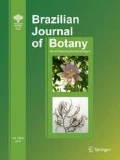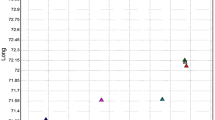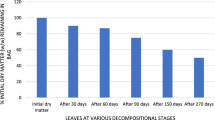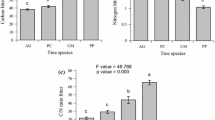Abstract
The use of nurse plants in ecological restoration aims to reactivate succession processes to improve environmental quality and biodiversity. This study targets Solanum lycocarpum as a nurse species to promote different plant species beneath its crown by microenvironmental changes in a disturbed area in Brazilian Savanna undergoing a process of restoration. The hypothesis is that S. lycocarpum modifies the microenvironment beneath its crown and influence in order to facilitate the density and richness of different plant species. Biotic parameter as density and species-rich biota, dispersal syndromes and habit were sampled. Additionally abiotic parameters were evaluated: litter thickness, light interception, penetration resistance, moisture, soil bulk density, saturated hydraulic conductivity of soil, nutrient content, acidity and soil structure. These parameters were evaluated in ten sampling units beneath S. lycocarpum, called the area of direct influence, ten around the nurse species crown, in the area of indirect influence and ten in open fields nearby without the influence of other trees, in the control area. For the biotic factors, density and species richness were higher beneath the crown of S. lycocarpum than in other treatments, mainly due to more litter accumulation, light interception, higher nutrient content (potassium, calcium and magnesium), more moisture and lower penetration resistance. Results showed the importance of S. lycocarpum as a nurse species in a Brazilian Savanna area, because of their role in local microenvironmental changes to facilitate other plant species and promote succession processes.


Similar content being viewed by others
References
Aide MT, Cavelier J (1994) Barriers to lowland tropical forest restoration in the Sierra Nevada de Santa Marta, Colombia. Restor Ecol 2:219–229
Aires SS, Ferreira AG, Borghetti F (2005) Efeito alelopático de folhas e frutos de Solanum lycocarpum A. St.-Hil. (Solanaceae) na germinação e crescimento de Sesamun indicum L. (Pedaliaceae) em solo sob três temperaturas. Acta Bot Bras 19:339–344
Albuquerque LB, Aquino FG, Miranda ZJ, Costa LC, Sousa SR (2013) Espécies de melastomataceae juss. com potencial para restauração ecológica de mata ripária no Cerrado. Polibot 35:15–33
Araújo JF, Haridasan M (2007) Relação entre deciduídade e concentrações foliares de nutrientes em espécies lenhosas do Cerrado. Braz J Bot 30:533–542
Brady NC (1989) Natureza e propriedades dos solos. Freitas Bastos, Rio de Janeiro
Callaway RM (1995) Positive interaction among plants. Bot Rev 61:306–349
Campos JM (1994) O eterno plantio: um reencontro com a natureza. Pensamento, São Paulo
Carmona R, Martins CR, Fávero AP (1998) Fatores que afetam a germinação de sementes de gramíneas nativas do Cerrado. Revista Brasileira Sementes 20:16–22
Carnevale NJ, Montagnini F (2002) Facilitating regeneration of secondary forests with the use of mixed and pure plantations of indigenous tree species. For Ecol Manag 163:217–227
Castro J, Zamora R, Hodar JÁ, Gomez JM (2002) Use of shrubs as nurse plants: a new technique for reforestation in mediterranean mountains. Restor Ecol 10:297–305
Castro J, Zamora R, Hódar JA, Gómez JM, Gómez-Aparicio L (2004) Benefits of using shrubs as nurse plants for reforestation in Mediterranean mountains: a 4-year study. Restor Ecol 12:352–358
Chaves Filho JT, Stacciarini-Seraphin E (2001) Alteração no potencial osmótico e teor de carboidratos solúveis em plantas jovens de lobeira (Solanum lycocarpum A. St.-Hil.) em resposta ao estresse hídrico. Braz J Bot 24:199–204
Connell JH, Slatyer R (1977) Mechanisms of succession in natural communities and their role in community stability and organization. Am Nat 111:1119–1144
Corrêa Dias AT, Teixeira Zaluar HL, Ganade G, Scarano FR (2005) Canopy composition influencing plant patch dynamics in a Brazilian sandy coastal plain. J Trop Ecol 21:343–347
Embrapa (1997) Manual de Métodos de análise de solo. Centro Nacional de Pesquisa de Solos press, Rio de Janeiro
Felfili JM, Silva Júnior MC, Rezende AV, Machado JWB, Walter BMT, Silva P, Hay JD (1992) Análise comparativa da florística e fitossociologia da vegetação arbórea do Cerrado sensu stricto na Chapada Pratinha, DF, Brasil. Acta Bot Bras 6:27–46
Felippe GM, Silva JCS (1984) Estudos de germinação em espécies do Cerrado. Braz J Bot 6:157–163
Franks SJ (2003) Facilitation in multiple life-history stages: evidence for nucleated succession in coastal dunes. Plant Ecol 168:1–11
García D, Zamora R (2003) Persistence, multiple demographic strategies and conservation in long-lived Mediterranean plants. J Veg Sci 14:921–926
Gómez-Aparicio L, Zamora R, Gómez JM, Hódar JA, Castro J, Baraza E (2004) Applying plant facilitation to forest restoration: a meta-analysis of the use of shrubs as nurse plants. Ecol Appl 14:1128–1138
Guevara S, Purata SE, Van der Maarel E (1986) The role of remnant trees in tropical succession. Vegetatio 66:77–84
Guevara S, Meave J, Moreno-Casasola P, Laborde J (1992) Floristic composition and structure of vegetation under isolated trees in neotropic pastures. J Veg Sci 3:655–664
Hammer Ø, Harper DAT, Ryan PD (2001) PAST: paleontological statistics software package for education and data analysis. Palaeontol Electron 4:1–9 http://palaeo-electronica.org/2001_1/past/issue1_01.htm. Accessed 10 March 2012
Haridasan M (2000) Nutrição mineral de plantas nativas do Cerrado. Braz J Plant Physiol 12:54–64
Haridasan M, Pinheiro AAMC, Torres FRR (1997) Resposta de algumas espécies do estrato rasteiro de um Cerrado à calagem e à adubação. In: Leite LL, Saito CH (eds) Contribuição ao conhecimento ecológico do Cerrado. Universidade de Brasília press, Brasília, pp 87–91
Hoffmann WA (1996) The effects of fire and cover on seedling establishment in a neotropical Savanna. J Ecol 84:383–393
Holl KD (2002) Effect of shrubs on tree seedling establishment in an abandoned tropical pasture. J Ecol 90:179–187
Holmgren M, Scheffer M, Huston MA (1997) The interplay of facilitation and competition in plant communities. Ecology 78:1966–1975
Kellman M (1979) Soil enrichment by neotropical Savanna trees. J Ecol 67:565–577
Kissman KG (1997) Plantas infestantes e nocivas. BASF, São Paulo
Klink CA, Machado RB (2005) A conservação do Cerrado brasileiro. Megadiversidade 1:147–155
Klink CA, Moreira AG (2002) Past and current human occupation and land use. In: Oliveira PS, Marquis RJ (eds) The Cerrados of Brazil: ecology and natural history of neotropical Savanna. Columbia University Press, New York, pp 69–88
Lambeck RJ (1997) Focal species: a multi-species umbrella for nature conservation. Conserv Biol 11:849–856
Leite DS, Oliveira SCC (2007) Efeito de folhas de Solanum lycocarpum A. St.-Hil. e a influência de diferentes matrizes e idade das folhas no crescimento de Sesamum indicum L. Revista Brasileira de Biociências 5:1083–1085
Lemos Filho JP (2000) Fotoinibição em três espécies do Cerrado (Annona crassifolia, Eugenia dysenterica e Campomanesia adamantium) na estação seca e na chuvosa. Braz J Bot 23:45–50
Lombardi JA, Motta Junior JC (1993) Seed dispersal of Solanum lycocarpum A. St.-Hil. (Solanaceae) by the maned wolf, Chysocyon brachyurus Illiger (Mammalia, Canidae). Ciênc Cult 45:126–127
Lord JM, Norton DA (1990) Scale and the spatial concept of fragmentation. Conserv Biol 4:197–202
Marimon Júnior BH, Hay JD (2008) A new instrument for measurement and collection of quantitative samples of the litter layer in forests. For Ecol Manag 255:2244–2250
Marimon BS, Marimon-Junior BH, Feldpausch TR, Oliveira-Santos C, Mews HA, Lopez-Gonzales G, Lloyd J, Franczak, DD, Oliveira EA, Maracahipes L, Miguel A, Lenza E, Phillips OL (2014) Disequilibrium and hyperdynamic tree turnover at the forest–cerrado transition zone in southern Amazonia. Plant Ecol Divers 7:281–292
McClanahan TR, Wolfe RW (1993) Accelerating forest succession in a fragmented landscape: the role of birds and perches. Conserv Biol 7:279–287
McDonnell MJ, Stiles EW (1983) The structural complexity of old field vegetation and the recruitment of bird dispersed plant species. Oecologia 56:109–116
Mendonça RC, Felfili JM, Walter BMT, Silva-Júnior MC, Rezende AV, Filgueiras TS, Nogueira PE, Fagg CW (2008) Flora vascular do Bioma Cerrado: checklist com 12.356 espécies. In: Sano SM, Almeida SP, Ribeiro JF (eds) Cerrado: ecologia e flora. Embrapa Ciência e Tecnologia, Brasília, pp 423–442
Metzger JP (2003) Como restaurar a conectividade de paisagens fragmentadas? In: Kageyama PY (ed) Restauração ecológica de ecossistemas naturais. Fundação de Estudos e Pesquisa Agrícolas e Florestais (FEPAF) press, Botucatu, pp 49–76
Metzger JP (2006) Como lidar com regras pouco óbvias para conservação da biodiversidade em paisagens fragmentadas. Nat Conserv 4:11–23
Motta PEF, Curi N, Franzmeier DP (2002) Relation of soils and geomorphic surfaces in the Brazilian Cerrado. In: Oliveira PS, Marquis RJ (eds) The Cerrados of Brazil: ecology and natural history of neotropical Savanna. Columbia University Press, New York, pp 13–32
Oliveira FF (2006) Plantio de espécies nativas e uso de poleiros artificiais na restauração de uma área perturbada de Cerrado sentido restrito em ambiente urbano no Distrito Federal, Brasil. Dissertation, Universidade of Brasilia
Oliveira SCC, Ferreira AG, Borghetti F (2004) Efeito alelopático de folhas de Solanum lycocarpum A. St.-Hil. (Solanaceae) na germinação e crescimento de Sesamum indicum L. (Pedaliaceae) sob diferentes temperaturas. Acta Bot Bras 18:401–406
Oliveira Filho AT, Oliveira LCA (1988) Biologia floral de uma população de Solanum lycocarpum A. St.-Hil. (Solanaceae) em Lavras, MG. Rev Bras Bot 11:23–32
Oliveira Júnior EM, Santos CD, Abreu CMP, Corrêa AD, Santos JZL (2003) Análise nutricional da fruta-de-lobo (Solanum lycocarpum A. St.-Hil.) durante o amadurecimento. Ciênc Agrotec 2:846–851
Palmer MA, Ambrose RF, Poff NL (1997) Ecological theory and community restoration. Restor Ecol 5:291–300
Pivello VR (2005) Manejo de fragmentos de Cerrado: princípios para a conservação da biodiversidade. In: Scariot A, Sousa-Silva JC, Felfili JM (eds) Cerrado: ecologia, biodiversidade e conservação. Ministério do Meio Ambiente, Brasília, pp 402–413
Ratter JA, Ribeiro JF, Bridgewater S (1997) The Brazilian Cerrado vegetation and threats to its biodiversity. Ann Bot 80:223–230
Ratter JA, Bridgewater S, Ribeiro JF (2003) Analysis of the floristic composition of the Brazilian Cerrado vegetation. III: comparison of the woody vegetation of 376 areas. Edinb J Bot 60:57–109
Reatto A, Correia JR, Spera ST (2008) Solos do Bioma Cerrado: aspectos pedológicos. In: Sano SM, Almeida SP, Ribeiro JF (eds) Cerrado: ecologia e flora. Embrapa Ciência e Tecnologia, Brasília, pp 109–149
Reis A, Tres DR (2007). Nucleação: integração das comunidades naturais com a paisagem. In: Fundação Cargill (ed) Manejo ambiental e restauração de áreas degradadas, São Paulo, pp 28–56
Reis A, Bechara FC, Espindola MB, Vieira NK, Lopes L (2003) Restoration of damaged land areas: using nucleation to improve successional processes. Nat Conserv 1:85–92
Ren H, Yang L, Liu N (2008) Nurse plant theory and its application in ecological restoration in lower subtropics of China. Prog Nat Sci 18:137–142
Rodrigues RR, Gandolfi S (2000) Conceitos, tendências e ações para a recuperação de florestas ciliares. In: Rodrigues RR, Leitão Filho HF (eds) Matas ciliares: conservação e recuperação. Universidade de São Paulo press, São Paulo, pp 235–247
Salomão NA, Sousa-Silva JC, Davide AC, Gonzáles S, Torres RAA, Wetzel MMVS, Firetti F, Caldas LS (2003) Germinação de sementes e produção de mudas de plantas do Cerrado. Rede de Sementes do Cerrado press, Brasília
Sano EE, Rosa R, Brito JL, Ferreira LG (2008) Mapeamento semidetalhado do uso da terra do Bioma Cerrado. Pesquisa Agropecuária Brasileira 43:153–156
Santos MO, Coelho ADF, Montanari RM, Pinto ES, Viccini LF (2002) Variabilidade genética entre populações de lobeira (Solanum lycocarpum A. St.-Hil.). Floresta e Ambiente 9:158–164
Scarano FR (2002) Structure, function and floristic relationships of plant communities in stressful habitats marginal to the Brazilian Atlantic rainforest. Ann Bot 90:517–524
Silva-Junior MC (2005) 100 árvores do Cerrado: guia de campo. Rede de Sementes do Cerrado, Brasília
Silva FAM, Assad ED, Evangelista BA (2008) Caracterização climática do Bioma Cerrado. In: Sano SM, Almeida SP, Ribeiro JF (eds) Cerrado: ecologia e flora. Embrapa Informação e Tecnológia, Brasília, pp 71–88
Van der Pijl L (1982) Principles of dispersal in higher plants. Springer-Verlag, Berlin
Verdú M, Valiente-Banuet A (2008) The nested assembly of plant facilitation networks prevents species extinctions. Am Nat 172:751–60
Vidal MC, Stacciarini-Seraphin E, Câmara HHLL (1999) Crescimento de plântulas de Solanum lycocarpum A. St.-Hil. (lobeira) em casa de vegetação. Acta Bot Bras 13:271–275
Vieira DLM, Scariot A (2006) Principles of natural regeneration of tropical dry forests for restoration. Restor Ecol 14:11–20
Vieira ICG, Uhl C, Nepstad D (1994) The role of the shrub Cordia multispicata Cham. as a ‘succession facilitator’ in an abandoned pasture, Paragominas, Amazonia. Vegetatio 115:91–99
Yarranton GA, Morrison RG (1974) Spatial dynamics of a primary succession: nucleation. J Ecol 62:417–428
Young TP (2000) Restoration ecology and conservation biology. Conserv Biol 92:73–83
Young TP, Chase JM, Huddleston RT (2001) Community succession and assembly: comparing, contrasting and combining paradigms in the context of ecological restoration. Restor Ecol 19:5–18
Zaidan LBP, Carreira RC (2008) Seed germination in Cerrado species. Braz J Plant Physiol 20:167–181
Zaluar HLT, Scarano FR (2000) Facilitação em restingas de moitas: um século de buscas por espécies focais. In: Esteves FA, Lacerda LD (eds) Ecologia de restingas e lagoas costeiras. NUPEM/UFRJ, Macaé, pp 3–23
Acknowledgments
The authors thank the Coordination for the Improvement of Higher Education Personnel (CAPES), the University of Brasília (UnB), the Brazilian Agricultural Research Corporation (Embrapa Cerrados), the National Council for Scientific and Technological Research/CNPq (Project 561905/2010-0) and the National Institute of Meteorology (INMET) for funding and fellowships for the implementation of this research. This research is part of master’s dissertation in botany (Fábio B. Passos) and ecology (Camila M. Lopes) department at University of Brasilia (UnB).
Author information
Authors and Affiliations
Corresponding author
Additional information
Part of master’s dissertation from the two first authors. CAPES fellowship.
Rights and permissions
About this article
Cite this article
Passos, F.B., de Mesquita Lopes, C., de Gois Aquino, F. et al. Nurse plant effect of Solanum lycocarpum A. St.-Hil. in area of Brazilian Savanna undergoing a process of restoration. Braz. J. Bot 37, 251–259 (2014). https://doi.org/10.1007/s40415-014-0079-9
Received:
Accepted:
Published:
Issue Date:
DOI: https://doi.org/10.1007/s40415-014-0079-9




